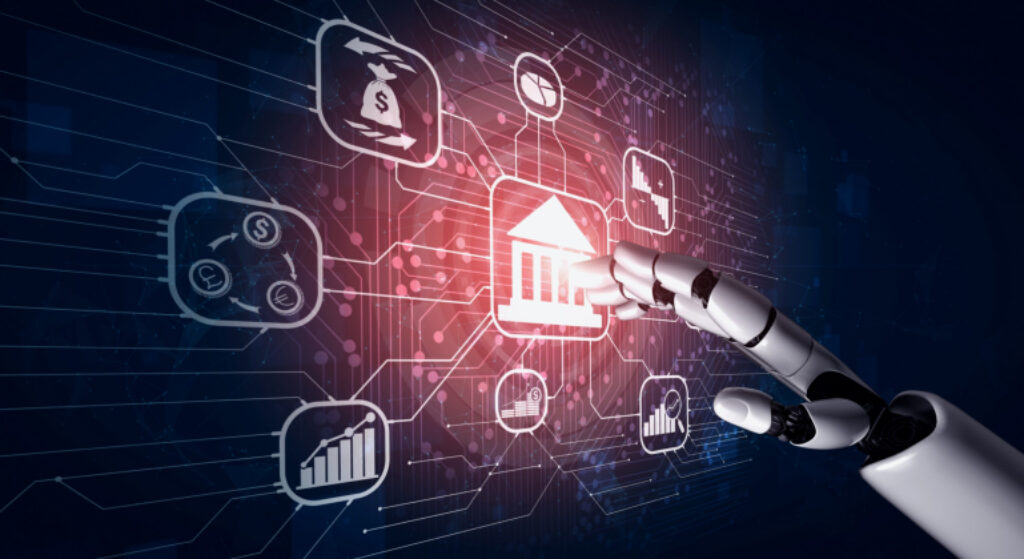
AI isn’t a new trend in the FinTech industry, but it continues to be at the forefront of innovation. It gives financial institutions a chance to transform their products and services, adapt to new realities, and change the way they do business in general. Therefore, a new banking trend has emerged in 2024 – the use of AI in banking.
The banking sector is undergoing a significant transformation thanks to the integration of Artificial Intelligence (AI). This cutting-edge technology is reshaping how banks operate, interact with customers, and secure transactions.
In this context, the role of a digital banking development company becomes crucial. These companies are the architects behind the seamless integration of AI into banking operations. By partnering with a reliable tech vendor, financial institutions can navigate the complexities of AI integration more effectively, ensuring they stay ahead in the competitive landscape of digital finance.
Keep reading this article as we are going to explore some real-world use cases of AI in banking, showcasing how this technology is making a difference.
AI In Banking: How Are Banks Using AI In 2024?
In order to cater to market and banking trends in 2024, banks are now using AI in banking in a broader way. Therefore, not only does the use of AI in banking help bands improve their customer support, but it also makes their daily operations easier and more efficient.
Therefore, here are various ways banks have been using AI in banking in 2024:
1. Personalized Banking Experiences

AI-powered solutions, such as chatbots and virtual assistants, can handle a wide range of customer inquiries, from balance checks to transaction queries, without human intervention.
Wells Fargo launched a chatbot that serves both banking customers and bank staff. It is capable of handling questions about account details, specific transactions, and broader inquiries, such as finding the closest ATMs. And it is all without human interaction.
Chase Bank developed a customer-friendly app that simplifies interactions through the use of facial recognition technology. This secure app allows users to manage their finances, including planning expenses, asking questions, seeking assistance, and depositing checks.
Bank of America’s virtual assistant, Erica, helps customers with banking tasks, sends notifications, and provides financial guidance, all through voice and text commands.
2. Minimizing Labor-Heavy Banking Processes

The banking industry is becoming more and more digital, but at the same time, it still has a lot of paperwork. In this matter, banks face operational expenses and risks associated with human mistakes. So, they are implementing AI to reduce or even completely remove this time-intensive and error-prone work.
JPMorgan uses AI to improve various internal operations. Its IT department utilizes multiple bots to perform functions that would typically need a team of people. Leveraging machine learning, conversational technology, and process automation, these bots can communicate with users in natural language to assist in resetting passwords, frequently eliminating the need for human intervention.
Citibank uses AI to streamline tasks associated with documentation in legal, compliance, and risk sectors. Additionally, the bank is integrating predictive analytics and forecasting tools into its operations. Currently, Citibank has implemented AI to monitor market changes by analyzing various data points, helping to assess risks, identify workforce requirements, and inform other future planning decisions.
3. Fraud Detection and Prevention

Fraud detection and prevention is one of the main tasks in the banking industry. AI systems can analyze millions of transactions in real-time, identifying patterns and anomalies that may indicate fraudulent activity.
For example, HSBC uses AI solutions to combat money laundering, using big data analytics to identify suspicious transactions among billions of data points.
4. Real-Time Transaction Monitoring
The use of AI in banking has allowed many banks to create new processes of real-time transaction monitoring.
Here, the AI will automatically monitor and generate a documented report of all transactions account holders have conducted over a specific period. Consequently, these transactions will also be updated on the user’s digital passbook in real time.
However, the use of AI here also allows banks to sport fraudulent behavior. For example, if money is withdrawn from an account from multiple locations in a short span of time, it could signal a cyber attack. Therefore, in a way, it helps banks improve their account security.
5. Automated Credit Checks And Loan Approvals
Getting a loan can be a long process since your loan request must get approval from the bank first. Until now, banks have representatives who make credit score and background checks of the customer. This takes a long time, which often beats the purpose of getting a loan for emergencies.
Therefore, to make this process shorter, AI in banking has become more prevalent. Here, the AI does the credit score and background checks in under a minute. Moreover, the AI generates a customer report regarding their creditworthiness, upon which the approval of the loan will depend.
6. AI Chatbots
Regarding the use of AI in banking, you must have heard about AI chatbots like ChatGPT and Microsoft Copilot, right? These are AI chatbots with which you can chat with to get answers to your queries.
Now, banks are incorporating the use of AI chatbots, which act as a mediator between the bank’s representatives and customers. Therefore, if customers have any problems or have certain queries regarding the bank’s services, they can simply chat with the bank’s chatbot from its website before getting on a call with a customer service representative.
7. Market And Customer Analysis
In order to cater their services to customers in the best way, banks must constantly analyze current banking trends. This allows banks to find new avenues of growth, along with identifying new technology and processes to enhance their services.
Therefore, banks are now using AI to analyze current banking trends and customer behavior. Here, the AI will generate reports regarding market trends and customer preferences using Machine Learning (ML). Consequently, these reports will help banks make new strategic decisions.
Conclusion
The growing use of AI in banking demonstrates the industry’s progress in providing more secure, personalized, and efficient services.
These real-world examples underscore AI’s potential to not only enhance customer experience but also fortify the banking sector against fraud and inefficiencies. As banks continue to harness the power of AI, the future of banking looks set to be more innovative and customer-focused than ever before.
More Resources:






